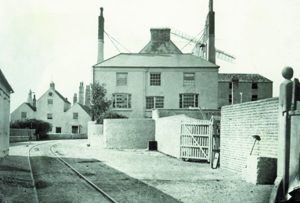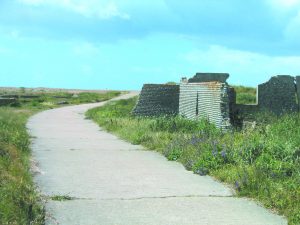The ebb and flow of tide mills
December 5, 2017
If you’re looking for a curious place to take a Boxing Day stroll, or a complete antidote to Christmas excess, then a visit to Tide Mills might suit your purposes. New interpretation panels show how much we are still learning about the history of this unusual nature reserve just across the river Ouse from the port of Newhaven.
Walking around Tide Mills today is a strange experience. You follow old stone walls and concrete trackways down to the beach, past old foundations of buildings. There are clear signs of industry, but where are the people? Who lived here and why is there so little left of their lives?
Fortunately for the curious the Sussex Archaeology Society have been ‘digging’ into the stories of this abandoned community and a series of interpretation panels on the site, recently updated thanks to funding from East Sussex County Council, the South Downs National Park Authority and Newhaven Port and Properties (the site owners), explain the story of this strange place.
Tide Mills was ‘born’ in 1761 when the Duke of Newcastle granted permission for three West Sussex corn merchants to build a dam and tidal mill where a former course of the river Ouse met the sea and a village grew up around the business. A new railway line connected it to Newhaven and Seaford in 1864 but the mill finally closed in 1883. However, the village continued.
After the mill closed a wireless relay station was established on the beach closer to the harbour and a Great War seaplane base was established in 1917 to combat the submarine threat. In the 1920s it was the home of Captain David Dale’s racing stables and a hospital for sick children. Once the villagers were evacuated by 1941, Tide Mills first had defences put up and was then used for military training. At the end of World War II what remained of the settlement were removed.


“With such recent history you’d think there would be nothing new to find here,” says Luke Barber, Research Officer for the Sussex Archaeology Society. “But we’re still finding buildings we didn’t know about. The many old maps and photographs clearly do not tell the whole story”
Luke has been leading excavations on the site since 2006 and one recent find is one of the country’s first excavated ‘pineapple pits’. “One of the mill owners, William Catt, grew very wealthy and was clearly a great horticulturist, who perhaps wanted to impress people with his ability to grow tropical fruit. His sunken pineapple pit would have originally been heated with manure – allowing him to grow fresh pineapples right here next to Newhaven!”
“We are revealing the stories of real, local people’s lives. We can even, just about, talk to the people who lived here at the end of the village’s life. I took one lady to the site of the room where her brother was born. We stood by the fireplace where her mother probably sat as she nursed him.”
As it’s by the sea and next to the Ouse Estuary nature reserve, Tide Mills is also a good spot for birdwatching with species such as purple sandpiper and ringed plover visiting the site. Other wildlife to look out for here includes the long tailed blue butterfly – a rare migrant which has been visiting the site for the last few years, grass snakes and other reptiles. The rare shingle habitat is good for coastal flora species such as yellow horned poppy and sea kale.
Find out more about the history Tidemills and get involved with the Friends of Tidemills group
